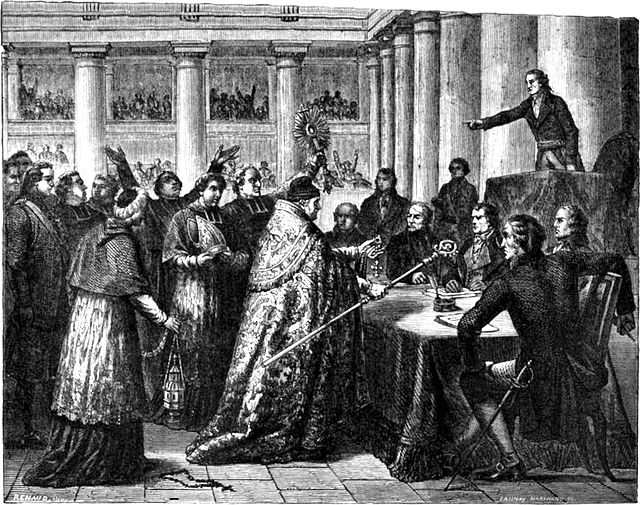Civil Constitution of the Clergy
The Civil Constitution of the Clergy was a law passed on 12 July 1790 during the French Revolution, that sought the complete control over the Catholic Church in France by the French government. As a result, a schism was created, resulting in an illegal and underground French Catholic Church loyal to the Papacy, and a "constitutional church" that was subservient to the State. The schism was not fully resolved until 1801. King Louis XVI ultimately granted Royal Assent to the measure after originally opposing it, but later expressed regret for having done so.
A commemorative plate from 1790 shows a curé swearing to the Constitution.
In this caricature, after the decree of 16 February 1790, monks and nuns enjoy their new freedom.
Members of the Catholic Church taking the oath that was required by the Civil Constitution of the Clergy.
Victor Henri Juglar, Plundering of a church during the French Revolution of 1793, Vizille, Museum of the French Revolution
The French Revolution was a period of political and societal change in France that began with the Estates General of 1789, and ended with the coup of 18 Brumaire in November 1799 and the formation of the French Consulate. Many of its ideas are considered fundamental principles of liberal democracy, while its values and institutions remain central to modern French political discourse.
The Storming of the Bastille, 14 July 1789
Caricature of the Third Estate carrying the First Estate (clergy) and the Second Estate (nobility) on its back
Le Serment du Jeu de paume by Jacques-Louis David (c. 1791), depicting the Tennis Court Oath
The Storming of the Bastille on 14 July 1789; the iconic event of the Revolution, still commemorated each year as Bastille Day








